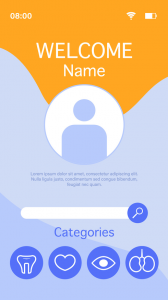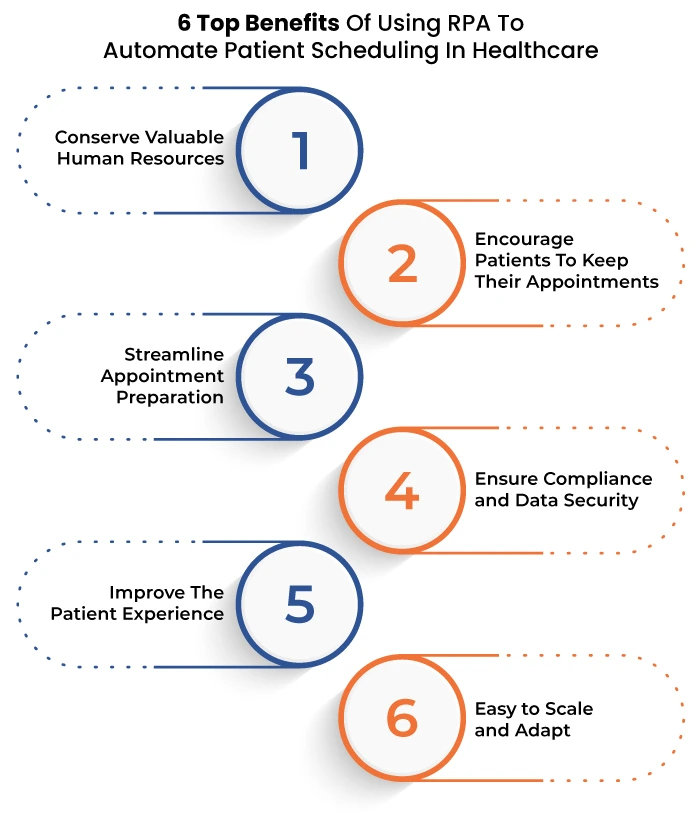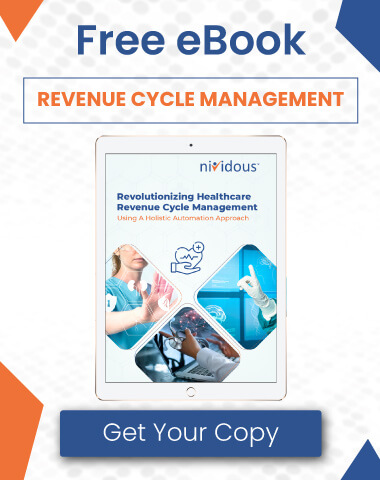Although the pandemic motivated significant digital transformation in healthcare, especially around online services and vaccine scheduling, many providers are still missing out on the significant benefits an automated patient scheduling process offers. In fact, 60% of top U.S. hospitals do not allow new patients to schedule online.
How Can Patient Scheduling Be Improved?
Patient scheduling is a critical aspect of healthcare operations, and improving it with robotic process automation (RPA) can bring significant benefits. RPA can automate repetitive, time-consuming tasks such as appointment booking and confirmation calls. Additionally, intelligent automation can use data analytics and AI algorithms to predict patient demand patterns, helping allocate resources efficiently and reduce patient wait times. Automated patient scheduling saves money, time, and worker resources, enhances the patient experience, and ultimately encourages better health outcomes.
6 Top Benefits Of Using RPA To Automate Patient Scheduling In Healthcare
RPA bots can be deployed as a powerful solution to common patient scheduling challenges, including overworked call centers, complicated confirmation and appointment update procedures, extensive manual data entry, and frustrating processes for patients. Read on to learn how automation addresses these difficulties and provides four essential benefits.
1. Conserve Valuable Human Resources
Busy medical offices often use call centers to field a high volume of scheduling requests. Managing these calls poses a number of challenges to human workers, including:
- Scheduling for the right location
- Finding the earliest available time that suits both provider and patient
- Ensuring patient appointment data is inputted correctly
- Minimizing hold times
- Imparting key information to the patient (like arrival time and procedures, for example)

RPA bots are capable of correctly scheduling appointments without incurring wait times or haggling over dates. RPA enhances accuracy and handles high volume with consistent efficiency, allowing patients to schedule anytime, day or night. Bots can also be used to share and collect vital data.
Want to learn more about RPA features?
Download our free RPA eBook guide to learn more about its time-saving and resource-saving capabilities.
2. Encourage Patients To Keep Their Appointments
No-shows are costly for medical providers. According to Health Management Technology, missed appointments cost the medical industry $150 billion dollars per year. Missed appointments can also contribute to attrition and poorer health outcomes. Healthcare providers are increasingly prioritizing the appointment reminder process, sending SMS and email reminders or using robocallers.
These methods are useful immediately after scheduling to confirm and a few days before appointments. But many clinics and offices still use human workers to make reminder calls, most of which go to voicemail as a result of call screening. With RPA, automated appointment reminders can free up valuable human resources and encourage patients to keep appointments with automated reminders and easier rescheduling.
Appointment changes are all time-consuming, and require nearly the same resources as the initial appointment scheduling with no additional revenue. Until payment is made, every time an appointment is shifted by a human worker, the provider loses money. Not to mention any follow-up that is required to shift appointments to an earlier time for people with urgent needs, or to contact those on a waitlist.
Using RPA to automate rescheduling and cancellation offers patients greater convenience and saves human workers for more valuable tasks. The processes of rescheduling and canceling can also be integrated into automated appointment reminders—for example, a text message could say something like “reply CNCL to cancel your appointment.”
3. Streamline Appointment Preparation
To provide the best service and comply with regulations, medical providers need access to accurate patient data. Especially for new patients, the process of collecting this data can be time-consuming. Common asks include administrative details, patient insurance, medical history, symptoms, diagnoses, treatments, hospitalization, and medications, to name a few. Providers take different approaches to data collection—some collect it over the phone, some send forms via email to be printed out (and then manually digitized by staff), some collect electronic forms via email or through a portal, and some provide printed forms upon arrival.
One major benefit to automation in patient scheduling is the opportunity to collect data at the time of appointment scheduling in a digital format using RPA. Not only does this save administrative time, but it also gives providers key data earlier, allowing them to thoroughly prepare to provide outstanding care. It’s a poor use of everyone’s time for a patient to complete a form in-office, for example, and then wait while a provider reads the form immediately before treating them.
4. Ensure Compliance and Data Security
Healthcare is a highly regulated industry, and patient data privacy is paramount. Besides using the RPA bots to prepare the data before the patient's visit, RPA systems can also be leveraged to adhere to strict compliance standards, ensuring that patient information is handled securely and per regulations like HIPAA. Bots can encrypt and store data in a controlled environment, reducing the risk of data breaches or unauthorized access, which could result in severe legal and financial consequences for healthcare providers.
5. Improve The Patient Experience
Medical providers are always looking for ways to improve care and enhance the patient experience. Each of the aforementioned benefits to automated patient scheduling have positive implications for patients:
Easier scheduling. With RPA, a patient can begin the scheduling process when it’s convenient for them. They will never get a busy signal, wait on hold, or get disconnected. They don’t have to remember to call back. Bots can prompt them to select the right location and best available time.
Easier updates. RPA can enable providers to set up auto-confirmations and appointment reminders. Receiving a text message with all appointment details is much easier than an appointment card or a call, especially when the patient can make real-time updates to their appointment using automation.
Easier data sharing. Taking care of scheduling and (often cumbersome) patient data collection simultaneously is easier on the patient, who doesn’t need to spend personal time on email forms or arrive early to complete paperwork. Ideally, they’ll also know sooner if services aren’t covered by their insurance.
Bottom line: Patients who have trouble scheduling, adjusting, or preparing for appointments are less likely to arrive and receive the services they need.
A better user experience for patients increases the chances for improved health outcomes as more patients show up to receive timely care.
6. Easy to Scale and Adapt
As healthcare needs evolve, RPA systems can quickly adapt to accommodate changes in patient scheduling requirements. Whether scaling up to handle increased patient volumes during flu season or adjusting scheduling rules to account for new healthcare services, RPA is flexible and scalable. This adaptability ensures that healthcare organizations can stay agile and responsive to the dynamic nature of the healthcare industry without the need for significant manual reconfiguration.
Case Study: How A Leading Eyecare Group Significantly Improved Patient Scheduling With AutomationThe Challenge: Consider a leading eyecare group on a rapid growth trajectory, with 300 practices operating in 14 U.S. states. Prior to implementing the Nividous automation platform, patients primarily made appointments via the group’s call center, which continuously required additional agents to meet demand. Not only that, the center’s core legacy system didn’t have the APIs that would allow the group to integrate with outside systems to help field customer inquiries and requests. The Solution: In partnership with Nividous, the eyecare group implemented a combination of voice- and chat-enabled RPA bots with cognitive capabilities to manage appointment scheduling. Patients are now able to interact with the bots using Google Assistant or text chat on the group’s website to locate their ideal location and quickly schedule appointments. With RPA, the bots interact with the group’s legacy system to make, change, or cancel patient appointments, as well as track customer orders.
As the group’s CIO observed, “The Nividous platform has proven to be a game changer to support our rapid growth. Our freed-up workforce can now focus more on delivering better customer services.” |
Take The First Step Toward Improving Your Patient Scheduling
For medical professionals looking to improve efficiency, save money, and prioritize patients through automated patient scheduling, Nividous’ intelligent automation platform is the perfect solution. And scheduling is just the beginning of what’s possible for intelligent automation in health care. Insurance pre-authorization, medical billing and coding, claims processing, revenue cycle management—automation can improve all these processes, helping providers ensure patient outcomes come first at every turn.
Reach out today to learn more and get started.
Ready to explore digital automation for your patient scheduling?
Get a trained automation bot in less than a month, at no risk, with Nividous Quick Start Program.







